TOYOTA COROLLA HATCHBACK 2020 Warranties & Maintenance Guides (in English)
Manufacturer: TOYOTA, Model Year: 2020, Model line: COROLLA HATCHBACK, Model: TOYOTA COROLLA HATCHBACK 2020Pages: 260, PDF Size: 8.54 MB
Page 41 of 260
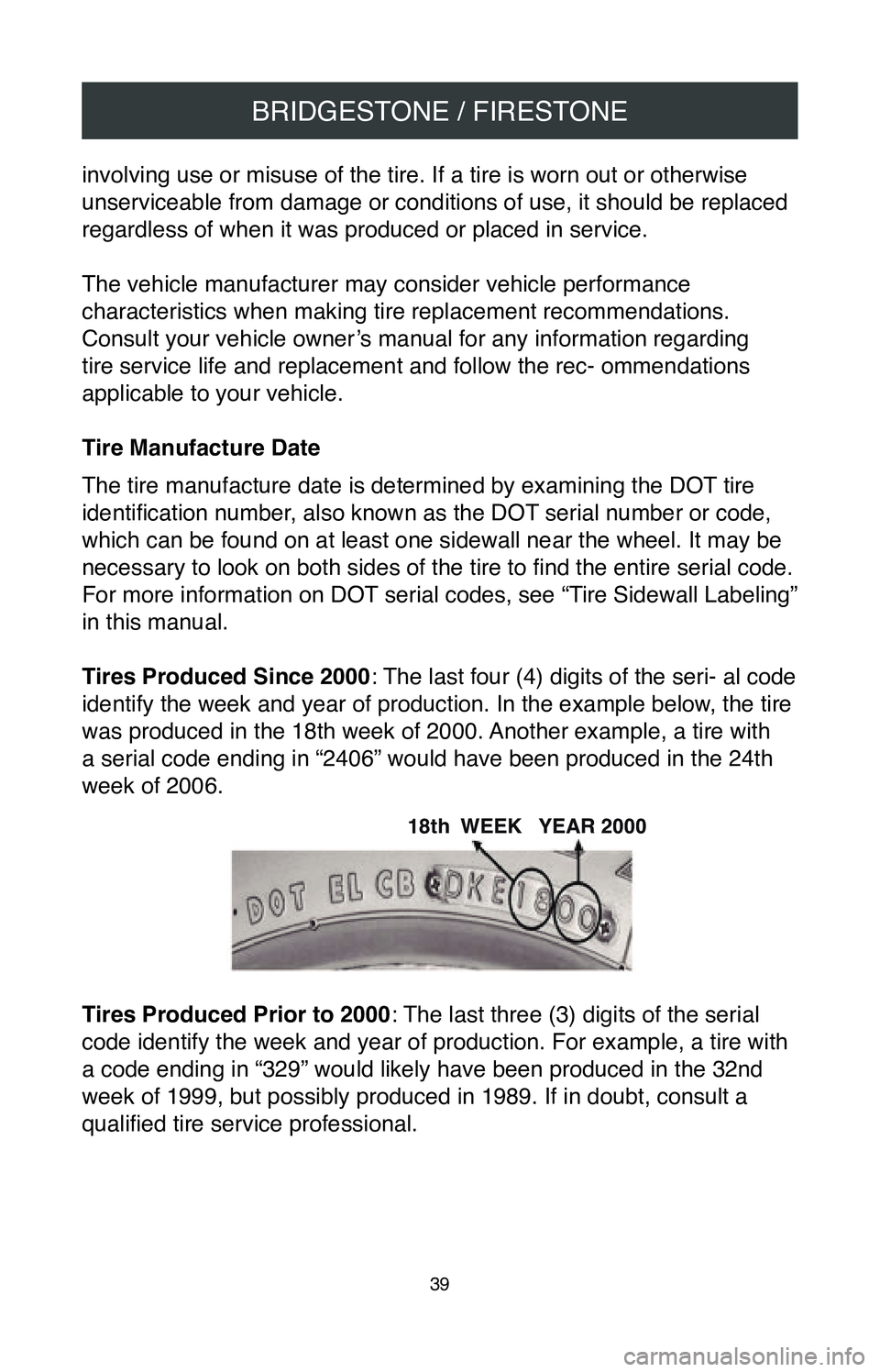
BRIDGESTONE / FIRESTONE
39
involving use or misuse of the tire. If a tire is worn out or otherwise \
unserviceable from damage or conditions of use, it should be replaced
regardless of when it was produced or placed in service.
The vehicle manufacturer may consider vehicle performance
characteristics when making tire replacement recommendations.
Consult your vehicle owner’s manual for any information regarding
tire service life and replacement and follow the rec- ommendations
applicable to your vehicle.
Tire Manufacture Date
The tire manufacture date is determined by examining the DOT tire
identification number, also known as the DOT serial number or code,
which can be found on at least one sidewall near the wheel. It may be
necessary to look on both sides of the tire to find the entire serial code.
For more information on DOT serial codes, see “Tire Sidewall Labeling”
in this manual.
Tires Produced Since 2000: The last four (4) digits of the seri- al code
identify the week and year of production. In the example below, the tire
was produced in the 18th week of 2000. Another example, a tire with
a serial code ending in “2406” would have been produced in the 24t\
h
week of 2006.
Tires Produced Prior to 2000: The last three (3) digits of the serial
code identify the week and year of production. For example, a tire with \
a code ending in “329” would likely have been produced in the 32nd\
week of 1999, but possibly produced in 1989. If in doubt, consult a
qualified tire service professional.
18th WEEK YEAR 2000
Page 42 of 260
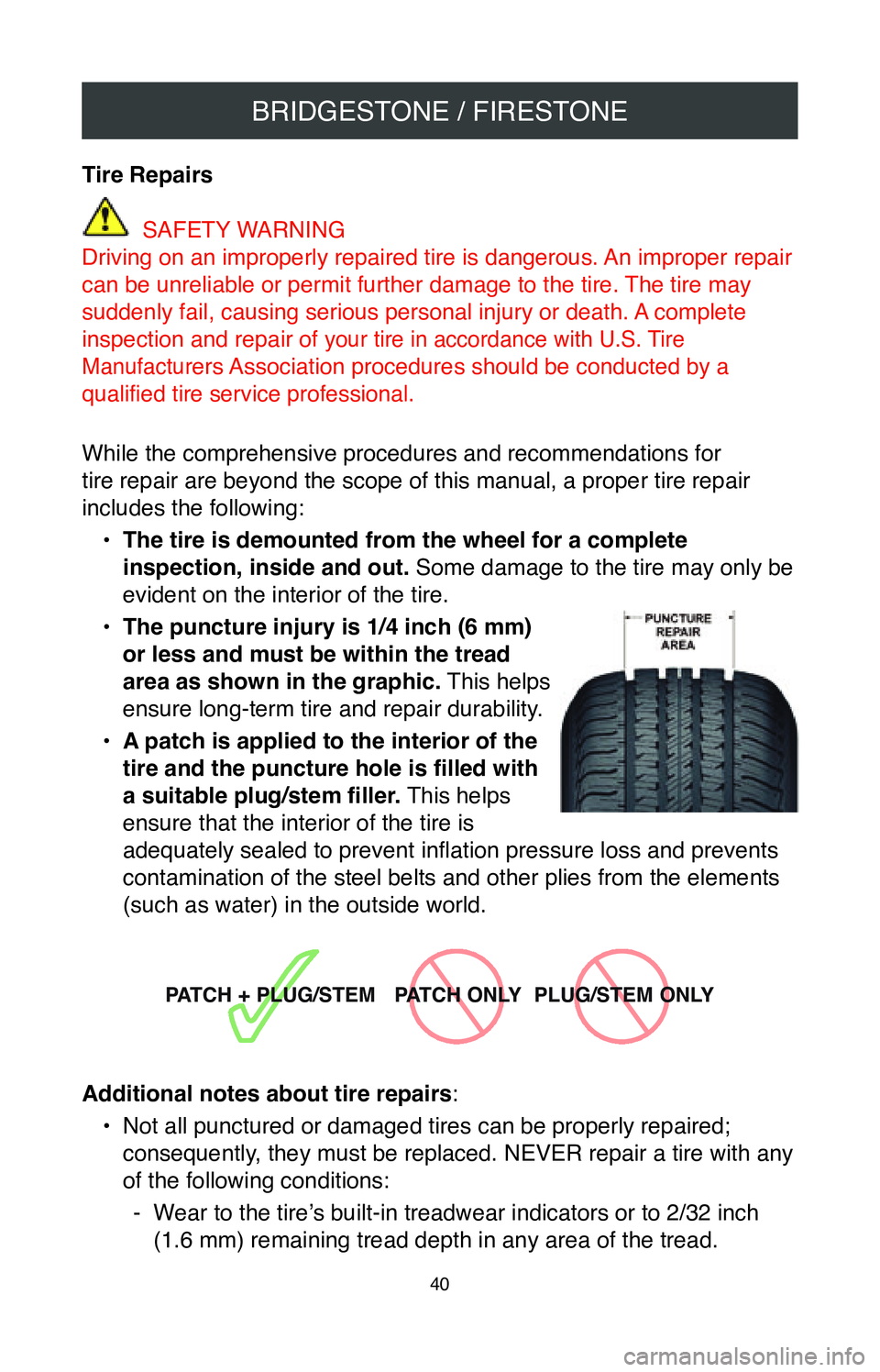
BRIDGESTONE / FIRESTONE
40
Tire Repairs
SAFETY WARNING
Driving on an improperly repaired tire is dangerous. An improper repair
can be unreliable or permit further damage to the tire. The tire may
suddenly fail, causing serious personal injury or death. A complete
inspection and repair of
your tire in accordance with U.S. Tire
Manufactur
ers Association procedures should be conducted by a
qualified tire service professional.
While the comprehensive procedures and recommendations for
tire repair are beyond the scope of this manual, a proper tire repair
includes the following:
•
The tire is demounted from the wheel for a complete
inspection, inside and out. Some damage to the tire may only be
evident on the interior of the tire.
•
The puncture injury is 1/4 inch (6 mm)
or less and must be within the tread
area as shown in the graphic. This helps
ensure long-term tire and repair durability.
•
A patch is applied to the interior of the
tire and the puncture hole is filled with
a suitable plug/stem filler. This helps
ensure that the interior of the tire is
adequately sealed to prevent inflation pressure loss and prevents
contamination of the steel belts and other plies from the elements
(such as water) in the outside world.
PATCH + PLUG/STEM PATCH ONLY PLUG/STEM ONLY
Additional notes about tire repairs :
•
Not all punctured or damaged tires can be properly repaired;
consequently, they must be replaced. NEVER repair a tire with any
of the following conditions:
- Wear to the tire’s built-in treadwear indicators or to 2/32 inch (1.6 mm) remaining tread depth in any area of the tread.
Page 43 of 260
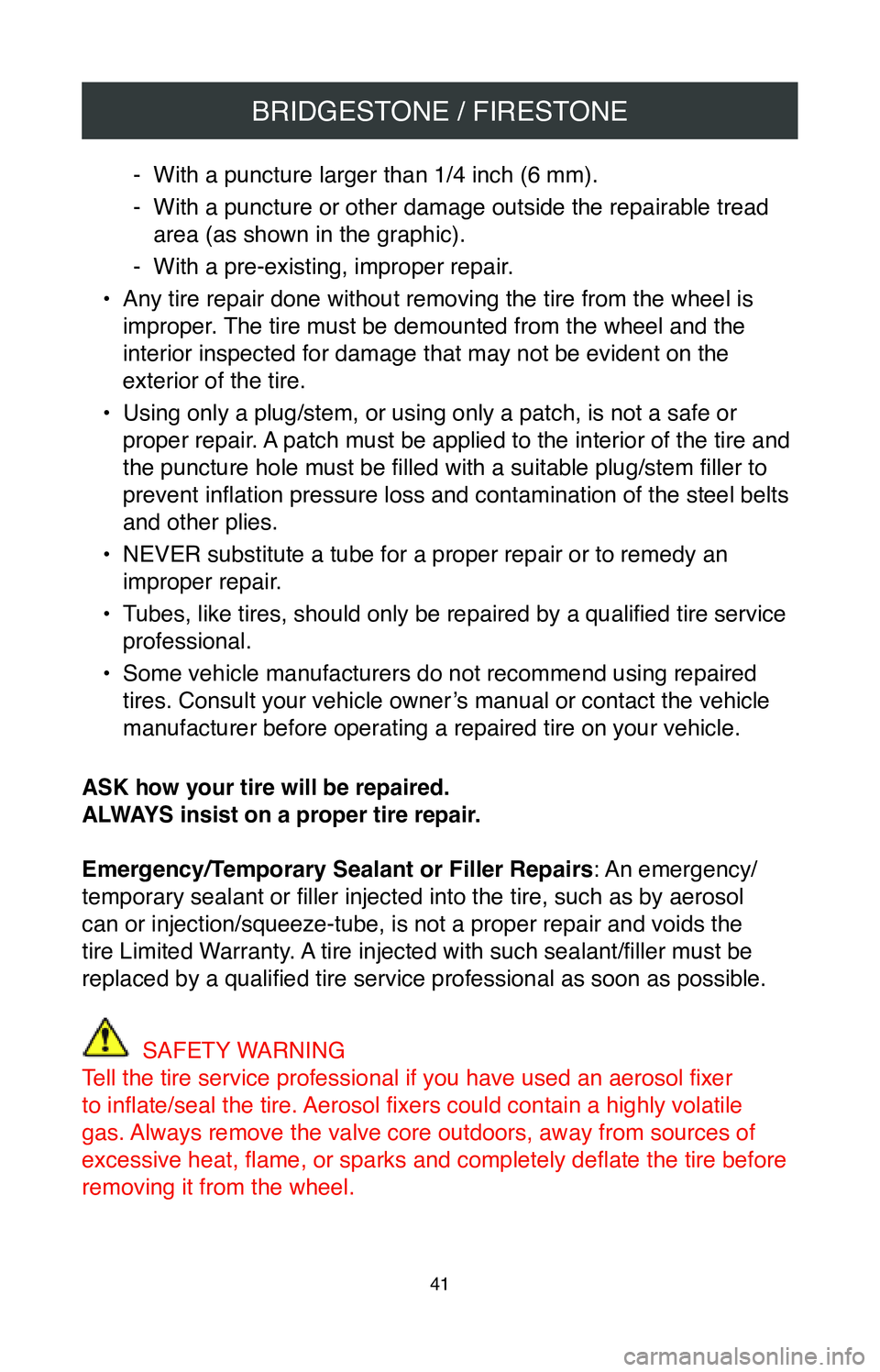
BRIDGESTONE / FIRESTONE
41
- With a puncture larger than 1/4 inch (6 mm).
-With a puncture or other damage outside the repairable tread
area (as shown in the graphic).
- With a pre-existing, improper repair.
•
Any tire repair done without removing the tire from the wheel is
improper. The tire must be demounted from the wheel and the
interior inspected for damage that may not be evident on the
exterior of the tire.
•
Using only a plug/stem, or using only a patch, is not a safe or
proper repair. A patch must be applied to the interior of the tire and
the puncture hole must be filled with a suitable plug/stem filler to
prevent inflation pressure loss and contamination of the steel belts
and other plies.
•
NEVER substitute a tube for a proper repair or to remedy an
improper repair.
•
Tubes, like tires, should only be repaired by a qualified tire service
professional.
•
Some vehicle manufacturers do not recommend using repaired
tires. Consult your vehicle owner’s manual or contact the vehicle
manufacturer before operating a repaired tire on your vehicle.
ASK how your tire will be repaired.
ALWAYS insist on a proper tire repair.
Emergency/Temporary Sealant or Filler Repairs: An emergency/
temporary sealant or filler injected into the tire, such as by aerosol
can or injection/squeeze-tube, is not a proper repair and voids the
tire Limited Warranty. A tire injected with such sealant/filler must be
replaced by a qualified tire service professional as soon as possible.
SAFETY WARNING
Tell the tire service professional if you have used an aerosol fixer
to inflate/seal the tire. Aerosol fixers could contain a highly volatile
gas. Always remove the valve core outdoors, away from sources of
excessive heat, flame, or sparks and completely deflate the tire before
removing it from the wheel.
Page 44 of 260
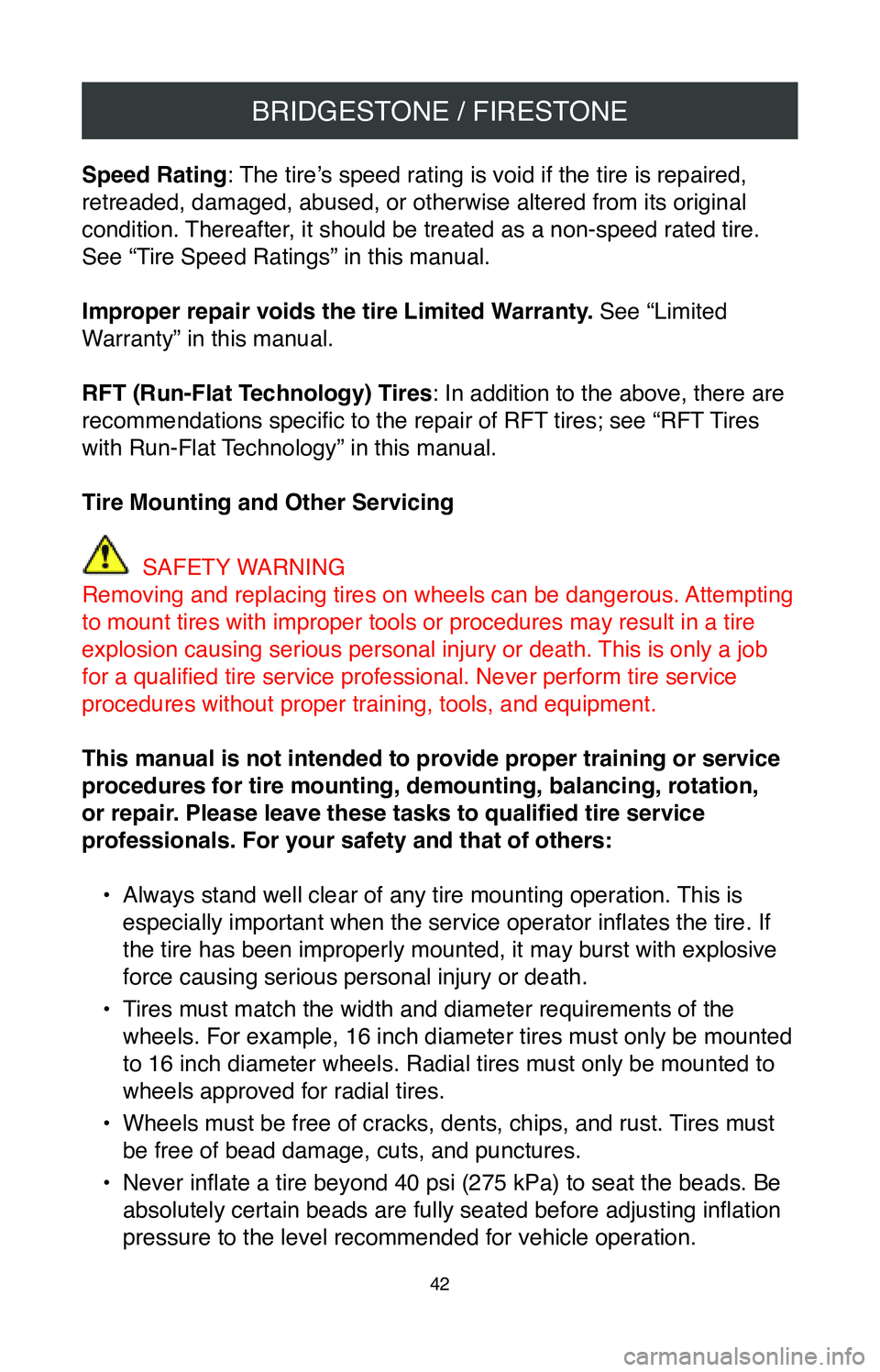
BRIDGESTONE / FIRESTONE
42
Speed Rating: The tire’s speed rating is void if the tire is repaired,
retreaded, damaged, abused, or otherwise altered from its original
condition. Thereafter, it should be treated as a non-speed rated tire.
See “Tire Speed Ratings” in this manual.
Improper repair voids the tire Limited Warranty. See “Limited
Warranty” in this manual.
RFT (Run-Flat Technology) Tires: In addition to the above, there are
recommendations specific to the repair of RFT tires; see “RFT Tires
with Run-Flat Technology” in this manual.
Tire Mounting and Other Servicing
SAFETY WARNING
Removing and replacing tires on wheels can be dangerous. Attempting
to mount tires with improper tools or procedures may result in a tire
explosion causing serious personal injury or death. This is only a job
for a qualified tire service professional. Never perform tire service
procedures without proper training, tools, and equipment.
This manual is not intended to provide proper training or service
procedures for tire mounting, demounting, balancing, rotation,
or repair. Please leave these tasks to qualified tire service
professionals. For your safety and that of others:
•
Always stand well clear of any tire mounting operation. This is
especially important when the service operator inflates the tire. If
the tire has been improperly mounted, it may burst with explosive
force causing serious personal injury or death.
•
Tires must match the width and diameter requirements of the
wheels. For example, 16 inch diameter tires must only be mounted
to 16 inch diameter wheels. Radial tires must only be mounted to
wheels approved for radial tires.
•
Wheels must be free of cracks, dents, chips, and rust. Tires must
be free of bead damage, cuts, and punctures.
•
Never inflate a tire beyond 40 psi (275 kPa) to seat the beads. Be
absolutely certain beads are fully seated before adjusting inflation
pressure to the level recommended for vehicle operation.
Page 45 of 260
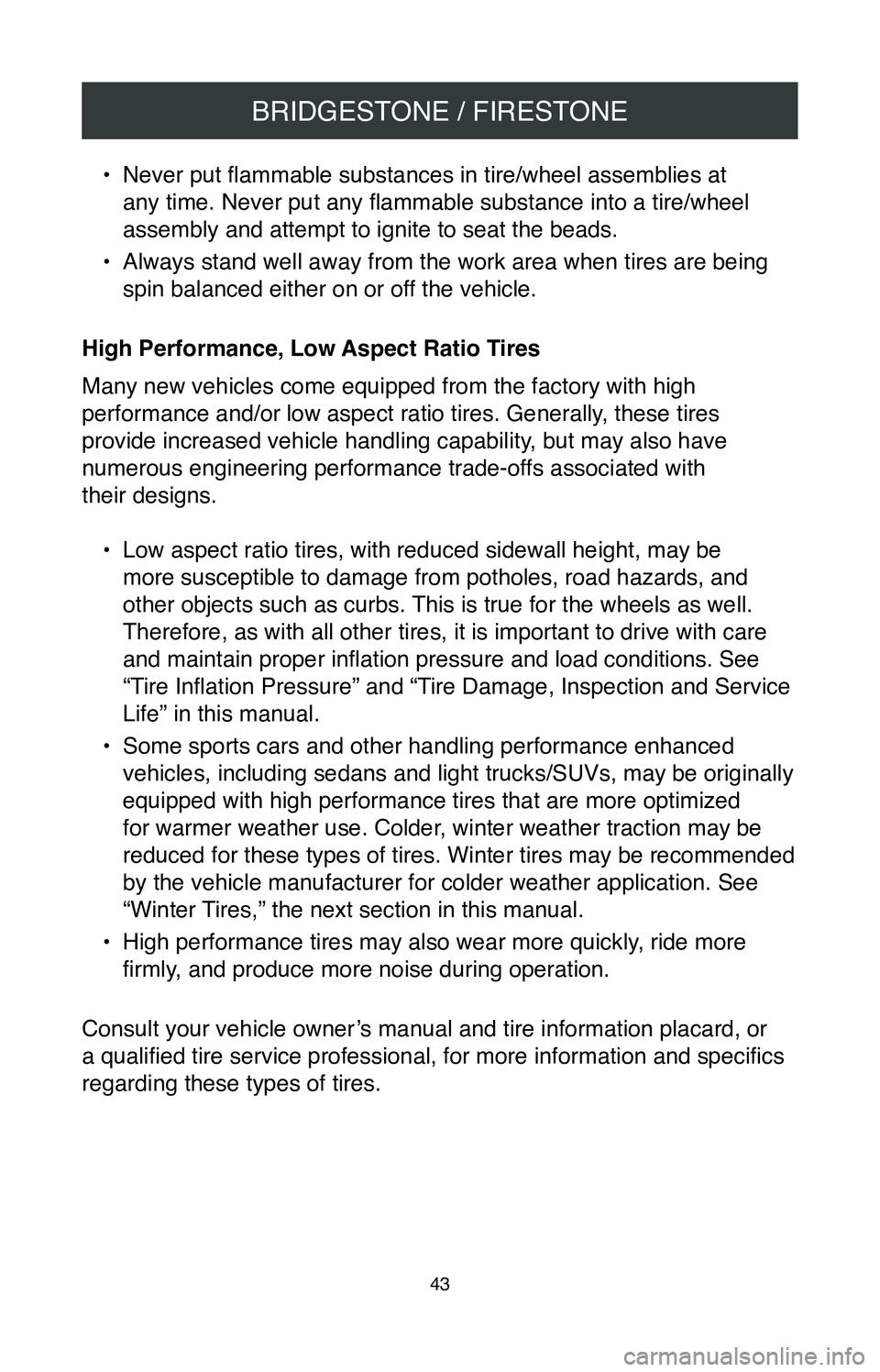
BRIDGESTONE / FIRESTONE
43
• Never put flammable substances in tire/wheel assemblies at
any time. Never put any flammable substance into a tire/wheel
assembly and attempt to ignite to seat the beads.
•
Always stand well away from the work area when tires are being
spin balanced either on or off the vehicle.
High Performance, Low Aspect Ratio Tires
Many new vehicles come equipped from the factory with high
performance and/or low aspect ratio tires. Generally, these tires
provide increased vehicle handling capability, but may also have
numerous engineering performance trade-offs associated with
their designs. •
Low aspect ratio tires, with reduced sidewall height, may be
more susceptible to damage from potholes, road hazards, and
other objects such as curbs. This is true for the wheels as well.
Therefore, as with all other tires, it is important to drive with care
and maintain proper inflation pressure and load conditions. See
“Tire Inflation Pressure” and “Tire Damage, Inspection and Service
Life” in this manual.
•
Some sports cars and other handling performance enhanced
vehicles, including sedans and light trucks/SUVs, may be originally
equipped with high performance tires that are more optimized
for warmer weather use. Colder, winter weather traction may be
reduced for these types of tires. Winter tires may be recommended
by the vehicle manufacturer for colder weather application. See
“Winter Tires,” the next section in this manual.
•
High performance tires may also wear more quickly, ride more
firmly, and produce more noise during operation.
Consult your vehicle owner’s manual and tire information placard, or
a qualified tire service professional, for more information and specifics
regarding these types of tires.
Page 46 of 260
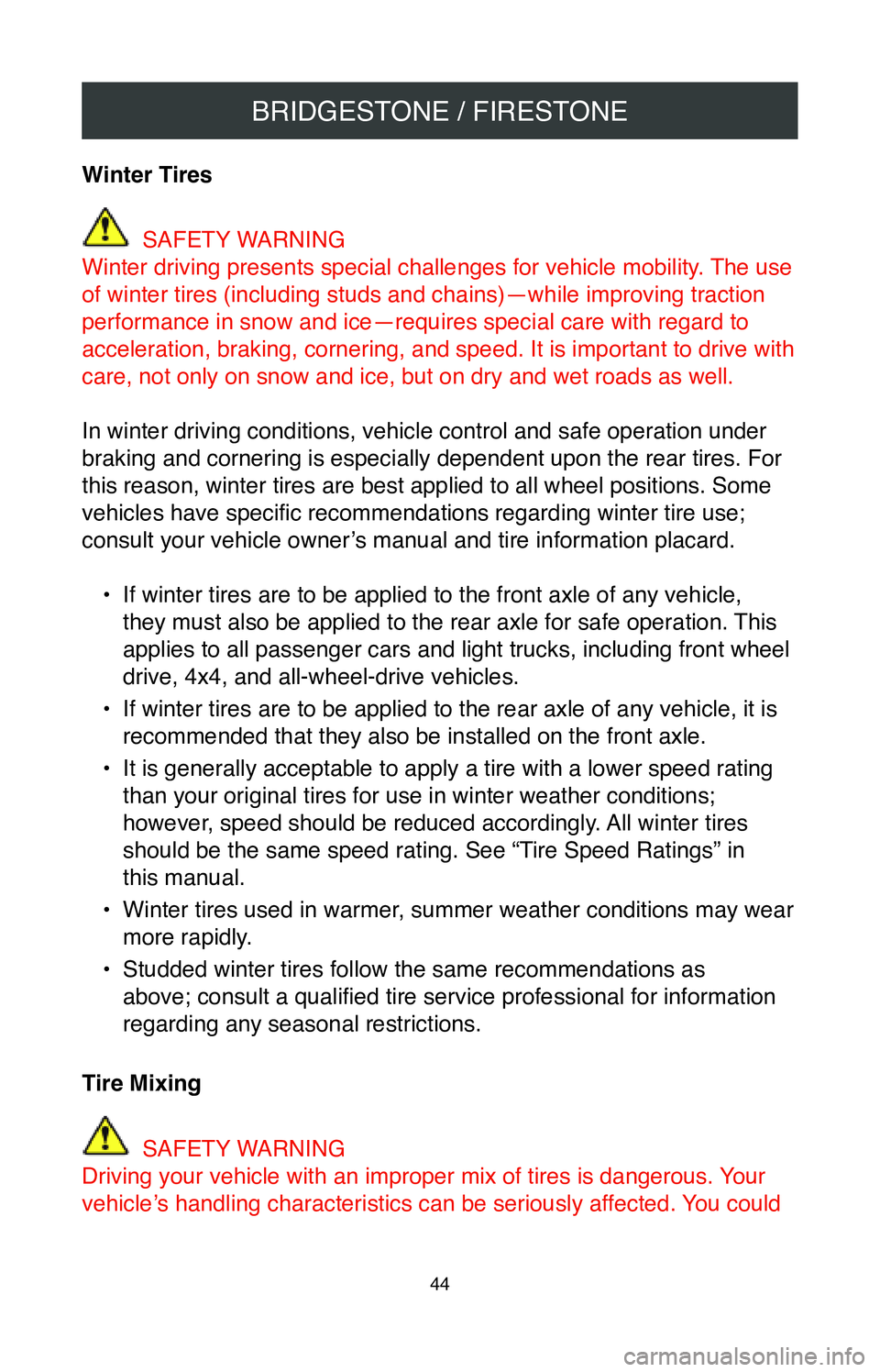
BRIDGESTONE / FIRESTONE
44
Winter Tires
SAFETY WARNING
Winter driving presents special challenges for vehicle mobility. The use
of winter tires (including studs and chains)—while improving traction
performance in snow and ice—requires special care with regard to
acceleration, braking, cornering, and speed. It is important to drive wi\
th
care, not only on snow and ice, but on dry and wet roads as well.
In winter driving conditions, vehicle control and safe operation under
braking and cornering is especially dependent upon the rear tires. For
this reason, winter tires are best applied to all wheel positions. Some \
vehicles have specific recommendations regarding winter tire use;
consult your vehicle owner’s manual and tire information placard.
•
If winter tires are to be applied to the front axle of any vehicle,
they must also be applied to the rear axle for safe operation. This
applies to all passenger cars and light trucks, including front wheel
drive, 4x4, and all-wheel-drive vehicles.
•
If winter tires are to be applied to the rear axle of any vehicle, it is\
recommended that they also be installed on the front axle.
•
It is generally acceptable to apply a tire with a lower speed rating
than your original tires for use in winter weather conditions;
however, speed should be reduced accordingly. All winter tires
should be the same speed rating. See “Tire Speed Ratings” in
this manual.
•
Winter tires used in warmer, summer weather conditions may wear
more rapidly.
•
Studded winter tires follow the same recommendations as
above; consult a qualified tire service professional for information
regarding any seasonal restrictions.
Tire Mixing
SAFETY WARNING
Driving your vehicle with an improper mix of tires is dangerous. Your
vehicle’s handling characteristics can be seriously affected. You could
Page 47 of 260
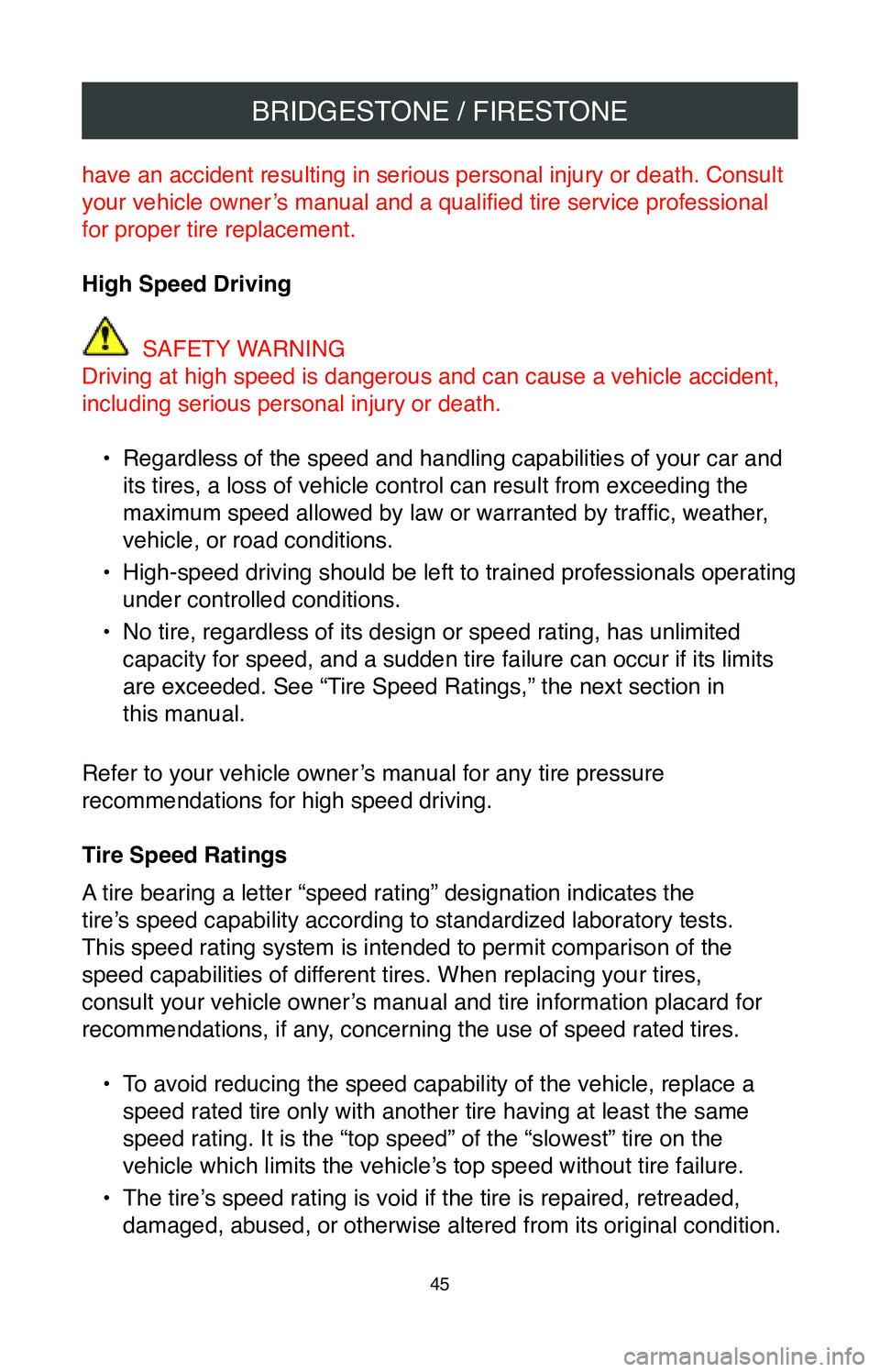
BRIDGESTONE / FIRESTONE
45
have an accident resulting in serious personal injury or death. Consult
your vehicle owner’s manual and a qualified tire service professional
for proper tire replacement.
High Speed Driving
SAFETY WARNING
Driving at high speed is dangerous and can cause a vehicle accident,
including serious personal injury or death.
•
Regardless of the speed and handling capabilities of your car and
its tires, a loss of vehicle control can result from exceeding the
maximum speed allowed by law or warranted by traffic, weather,
vehicle, or road conditions.
•
High-speed driving should be left to trained professionals operating
under controlled conditions.
•
No tire, regardless of its design or speed rating, has unlimited
capacity for speed, and a sudden tire failure can occur if its limits
are exceeded. See “Tire Speed Ratings,” the next section in
this manual.
Refer to your vehicle owner’s manual for any tire pressure
recommendations for high speed driving.
Tire Speed Ratings
A tire bearing a letter “speed rating” designation indicates the
tire’s speed capability according to standardized laboratory tests.
This speed rating system is intended to permit comparison of the
speed capabilities of different tires. When replacing your tires,
consult your vehicle owner’s manual and tire information placard for
recommendations, if any, concerning the use of speed rated tires. •
To avoid reducing the speed capability of the vehicle, replace a
speed rated tire only with another tire having at least the same
speed rating. It is the “top speed” of the “slowest” tire on\
the
vehicle which limits the vehicle’s top speed without tire failure.
•
The tire’s speed rating is void if the tire is repaired, retreaded,
damaged, abused, or otherwise altered from its original condition.
Page 48 of 260
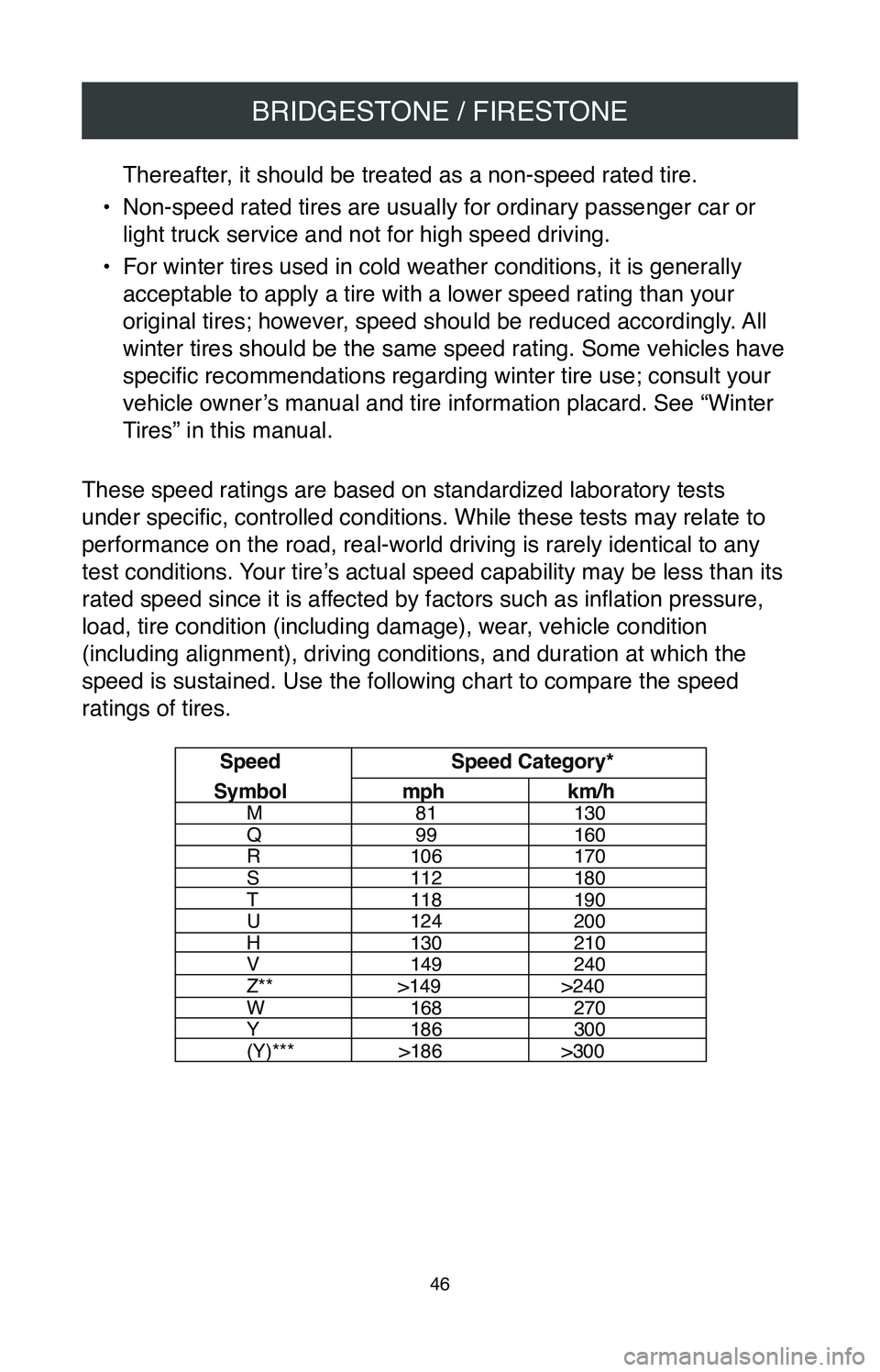
BRIDGESTONE / FIRESTONE
46
Thereafter, it should be treated as a non-speed rated tire.
•
Non-speed rated tires are usually for ordinary passenger car or
light truck service and not for high speed driving.
•
For winter tires used in cold weather conditions, it is generally
acceptable to apply a tire with a lower speed rating than your
original tires; however, speed should be reduced accordingly. All
winter tires should be the same speed rating. Some vehicles have
specific recommendations regarding winter tire use; consult your
vehicle owner’s manual and tire information placard. See “Winter
Tires” in this manual.
These speed ratings are based on standardized laboratory tests
under specific, controlled conditions. While these tests may relate to
performance on the road, real-world driving is rarely identical to any
test conditions. Your tire’s actual speed capability may be less than its
rated speed since it is affected by factors such as inflation pressure,
load, tire condition (including damage), wear, vehicle condition
(including alignment), driving conditions, and duration at which the
speed is sustained. Use the following chart to compare the speed
ratings of tires.
Speed Speed Category*
Symbol mph km/h
M81130
Q 99160
R 106170
S 112180
T 118190
U 124200
H 130210
V 149240
Z** >149 >240
W 168270
Y 186300
(Y)*** >186 >300
Page 49 of 260
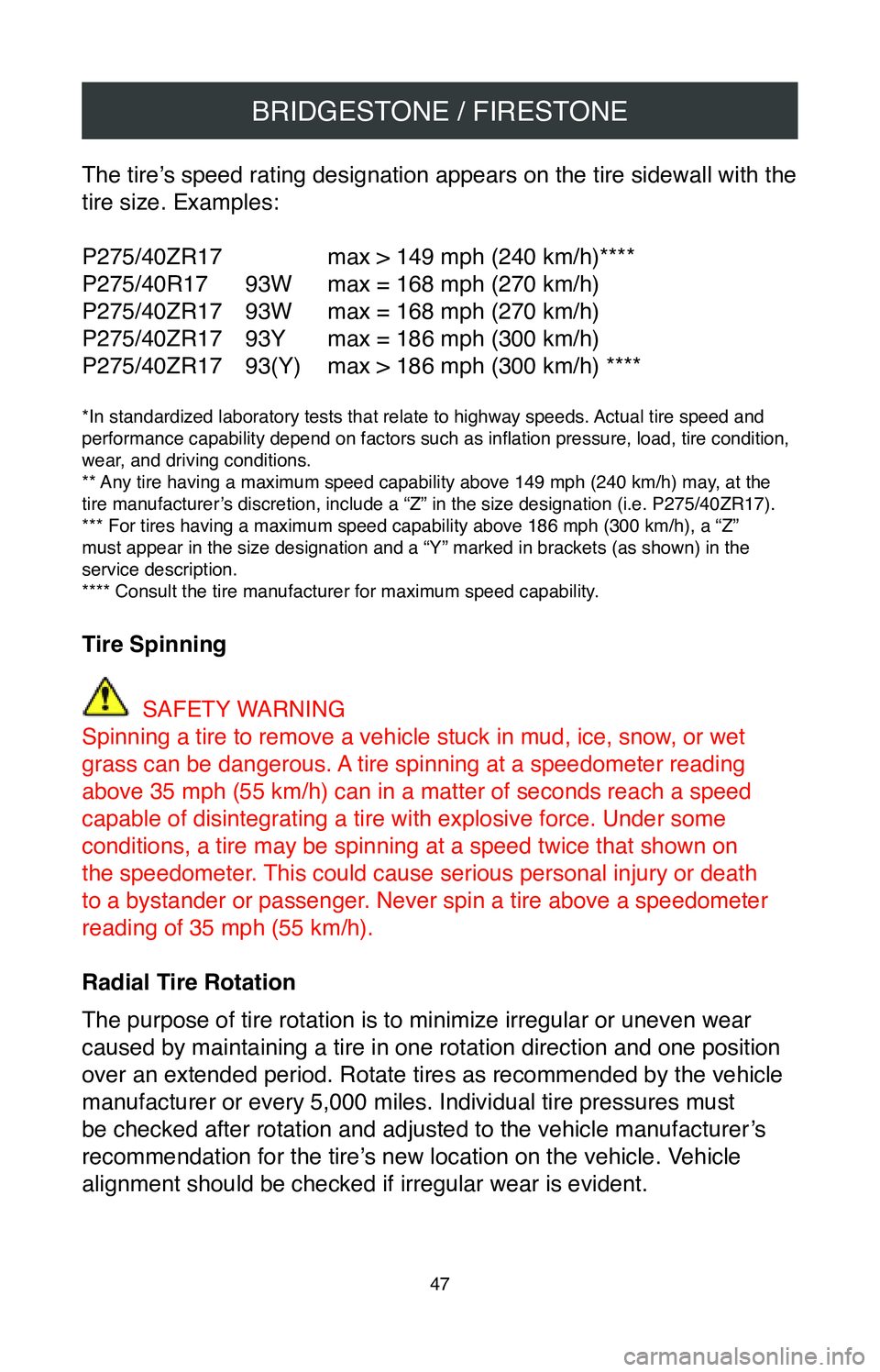
BRIDGESTONE / FIRESTONE
47
The tire’s speed rating designation appears on the tire sidewall with the
tire size. Examples:
P275/40ZR17
max > 149 mph (240 km/h)****
P275/40R17
93W max = 168 mph (270 km/h)
P275/40ZR17
93W max = 168 mph (270 km/h)
P275/40ZR17
93Y max = 186 mph (300 km/h)
P275/40ZR17
93(Y) max > 186 mph (300 km/h) ****
*In standardized laboratory tests that relate to highway speeds. Actual tire speed and
performance capability depend on factors such as inflation pressure, load, tire condition,
wear, and driving conditions.
** Any tire having a maximum speed capability above 149 mph (240 km/h) may, at the
tire manufacturer’s discretion, include a “Z” in the size designation (i.e. P275/40ZR17).
*** For tires having a maximum speed capability above 186 mph (300 km/h), a “Z”
must appear in the size designation and a “Y” marked in brackets (as shown) in the
service description.
**** Consult the tire manufacturer for maximum speed capability.
Tire Spinning
SAFETY WARNING
Spinning a tire to remove a vehicle stuck in mud, ice, snow, or wet
grass can be dangerous. A tire spinning at a speedometer reading
above 35 mph (55 km/h) can in a matter of seconds reach a speed
capable of disintegrating a tire with explosive force. Under some
conditions, a tire may be spinning at a speed twice that shown on
the speedometer. This could cause serious personal injury or death
to a bystander or passenger. Never spin a tire above a speedometer
reading of 35 mph (55 km/h).
Radial Tire Rotation
The purpose of tire rotation is to minimize irregular or uneven wear
caused by maintaining a tire in one rotation direction and one position \
over an extended period. Rotate tires as recommended by the vehicle
manufacturer or every 5,000 miles. Individual tire pressures must
be checked after rotation and adjusted to the vehicle manufacturer ’s
recommendation for the tire’s new location on the vehicle. Vehicle
alignment should be checked if irregular wear is evident.
Page 50 of 260
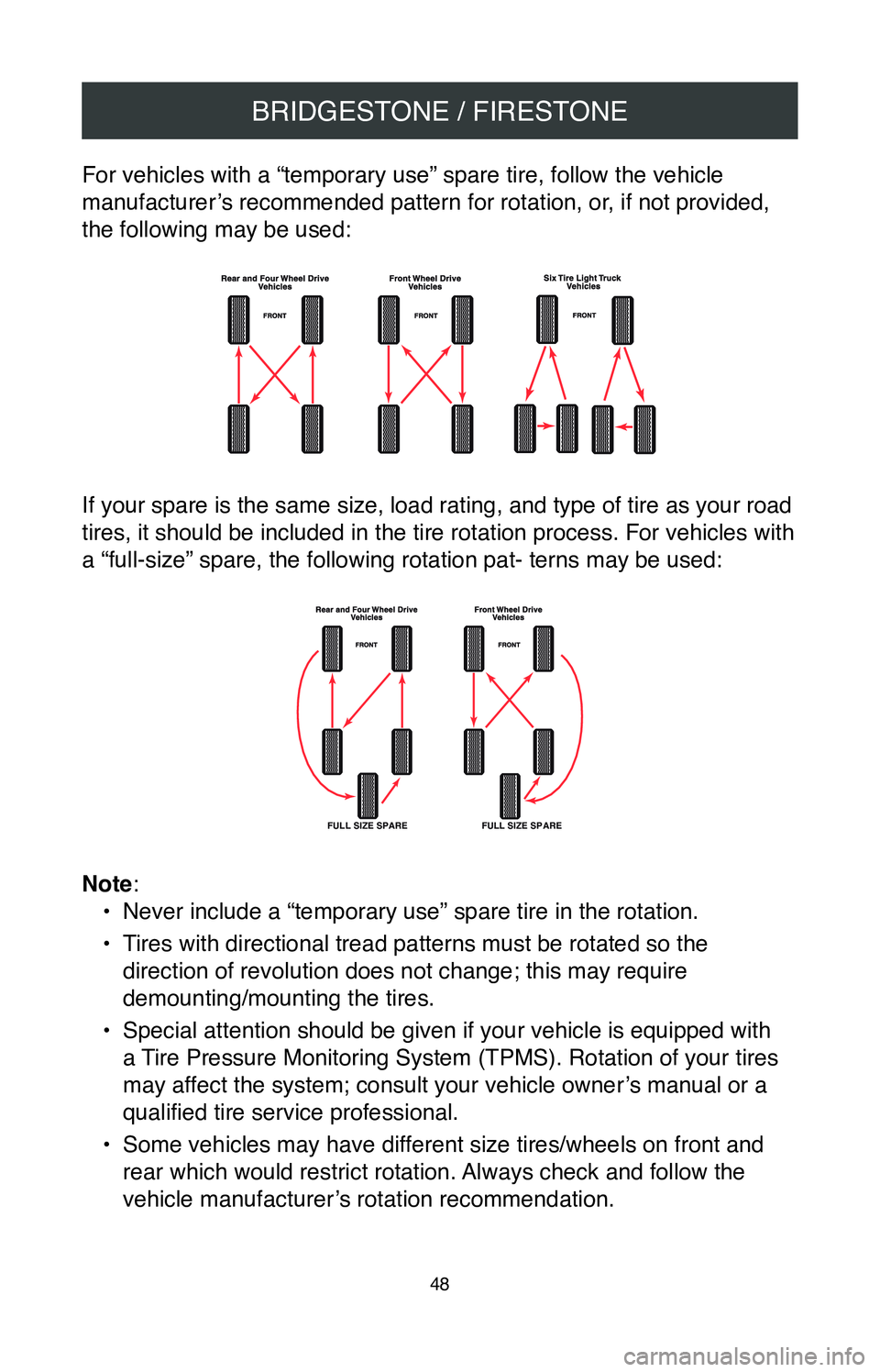
BRIDGESTONE / FIRESTONE
48
For vehicles with a “temporary use” spare tire, follow the vehicle\
manufacturer’s recommended pattern for rotation, or, if not provided,
the following may be used:
If your spare is the same size, load rating, and type of tire as your ro\
ad
tires, it should be included in the tire rotation process. For vehicles \
with
a “full-size” spare, the following rotation pat- terns may be used:
FULL SIZE SPAREFULL SIZE SPARE
Note:
•
Never include a “temporary use” spare tire in the rotation.
•
Tires with directional tread patterns must be rotated so the
direction of revolution does not change; this may require
demounting/mounting the tires.
•
Special attention should be given if your vehicle is equipped with
a Tire Pressure Monitoring System (TPMS). Rotation of your tires
may affect the system; consult your vehicle owner’s manual or a
qualified tire service professional.
•
Some vehicles may have different size tires/wheels on front and
rear which would restrict rotation. Always check and follow the
vehicle manufacturer’s rotation recommendation.